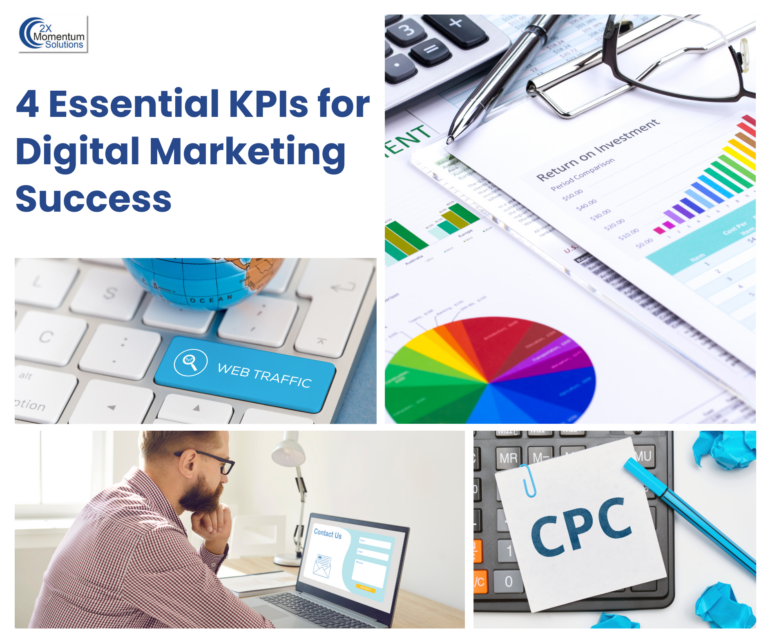Key Performance Indicators, or KPIs, are metrics that you can use to evaluate business performance in a specific area. Good data is the basis for good digital marketing, so KPIs are essential to your success!
But there are so many KPIs that you could choose to track—how do you know which KPIs to choose, or what to do if they’re off course?

In this article, we’ll cover four essential KPIs for digital marketing, why they’re important, and practical ideas for driving improvement in each area. These four KPIs are organic traffic, cost-per-click (CPC) for paid campaigns, webpage conversion rates, and return on marketing investment (ROMI).
1. Organic Traffic
This KPI tells you how much of your website traffic is coming from organic searches. A large amount of organic traffic usually means that your SEO strategy is working well! Your content is likely engaging and high-quality, and it’s resonating with customers.
Tips for improvement: If you’re not getting much organic traffic, take a look at your content and your user experience (UX). Low-quality content or poor UX—a page that loads slowly or isn’t optimized for mobile, for example—can tank organic traffic. If those areas are solid, it’s time to revisit your SEO strategy! Consider targeting less-competitive keywords.
2. Cost per click (CPC)
When you’re running a paid advertising campaign, your CPC is how much money you’re spending, on average, to get one lead. If your CPC is very high, your campaigns are likely inefficient and ineffective.
Tips for improvement: Try utilizing negative keywords. Negative keywords can exclude irrelevant terms that might accidentally get caught up in your ad targeting. For example, a company who sells adult running shoes might exclude terms like “kids” and “dress,” so that their ads don’t appear when people are searching for dress shoes or for kids’ shoes. Also, pay attention to Google’s “Quality Score” for your ads
3. Landing page conversion rate
This KPI shows how effective each landing page is at turning leads into customers. Pages with high conversion rates are user-friendly, engaging, and helpful!
Tips for improvement: If you’ve noticed some landing pages that aren’t converting well, first check that the call-to-action (CTA) is clear. Try using A/B testing to compare similar versions of the page and see what’s most effective. Make sure your page is optimized for mobile, as the majority of all website traffic is from mobile devices!
4. Return on marketing investment (ROMI)
This KPI looks at marketing revenue and cost to find profitability. You can look at the ROMI of a single campaign or of a whole channel. A high ROMI indicates money well-spent; a low ROMI is a sign to investigate and make changes.
Tips for improvement: Use ROMI to regularly evaluate marketing campaigns and channels so that you’re only continuing the profitable efforts. If your overall ROMI as a business is quite far from your goals, consider developing a new digital marketing strategy, keeping the 5 key digital marketing trends for 2024 in mind.
Putting your KPIs to use:
Now that you’ve seen how these four digital marketing KPIs are essential to your success, it’s time to put your knowledge to use! We hope this article helps you identify problems and implement solutions in your digital marketing strategy.
If you’d like some help choosing additional KPIs for your specific business goals, we’re here to help! Contact us for a FREE 60 minute consultation today.
